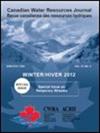Are temperature time series measured at hydrometric stations representative of the river’s thermal regime?
IF 1.7
4区 环境科学与生态学
Q3 WATER RESOURCES
引用次数: 2
Abstract
Abstract River temperature is a key variable for water quality assessment. It can alter different chemical water properties. Indeed, it is considered as determining criterion in the adequacy of cold water fish habitat, and the overall health of the river ecosystem and aquatic biota. Consequently, monitoring this variable and understanding the river thermal variation are highly important. Temperature monitoring along the rivers is often done by deploying autonomous temperature loggers. However, recently, temperature sensors were installed at hydrometric stations in conjunction with water level gauges for monitoring the river temperature, thereby providing an opportunity to expand the temperature network across the region and eventually, the country. In this study, a comparative analysis was conducted to find if the temperatures at the hydrometric station are representative of the river thermal variation upstream and downstream of that location. This comparative analysis was completed using a number of different statistical tools: entropy analysis, Gaussian function fit, and thermal sensitivity analysis. These statistical analyses confirm that temperature loggers that are collocated with the level gauges at hydrometric stations are generally representative of the thermal variation of the river main stem over a distance of a few tens of kilometres. However, the thermal variation observed in temperature loggers located at distances of the order of 100 km or in a different river reach than the hydrometric station, is different from that of the temperature logger located at the hydrometric station.水文站测量的温度时间序列是否代表河流的热状态?
摘要河流温度是水质评价的关键变量。它可以改变水的不同化学性质。事实上,它被认为是决定冷水鱼类栖息地是否充足的标准,以及河流生态系统和水生生物群的整体健康状况。因此,监测这一变量和了解河流热变化是非常重要的。沿着河流的温度监测通常是通过部署自动温度记录器来完成的。然而,最近在水文测量站安装了温度传感器,与水位计一起监测河流温度,从而提供了一个机会,将温度网络扩大到整个地区,并最终扩大到全国。本研究通过对比分析水文站的温度是否能代表该地点上下游的河流温度变化。对比分析使用了许多不同的统计工具:熵分析、高斯函数拟合和热敏性分析。这些统计分析证实,与水文站的液位计配合使用的温度记录仪通常能代表几十公里范围内河流干流的热变化。然而,在距离水文学站100公里或不同河段的温度记录仪观测到的热变化与水文学站的温度记录仪观测到的热变化不同。
本文章由计算机程序翻译,如有差异,请以英文原文为准。
求助全文
约1分钟内获得全文
求助全文
来源期刊

Canadian Water Resources Journal
WATER RESOURCES-
CiteScore
2.90
自引率
5.90%
发文量
17
审稿时长
>12 weeks
期刊介绍:
The Canadian Water Resources Journal accepts manuscripts in English or French and publishes abstracts in both official languages. Preference is given to manuscripts focusing on science and policy aspects of Canadian water management. Specifically, manuscripts should stimulate public awareness and understanding of Canada''s water resources, encourage recognition of the high priority of water as a resource, and provide new or increased knowledge on some aspect of Canada''s water.
The Canadian Water Resources Journal was first published in the fall of 1976 and it has grown in stature to be recognized as a quality and important publication in the water resources field.
 求助内容:
求助内容: 应助结果提醒方式:
应助结果提醒方式:


